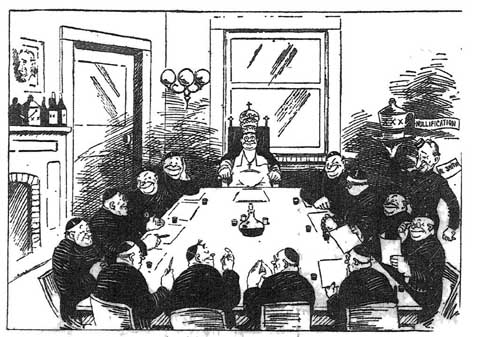Will the church of the future be on line?
We seem to be heading that way, says think-tank president Ron Sellers who points to recent findings that among American adults who use the Internet, 44 percent use it for religious purposes.
“This is particularly common among younger Americans,” says Sellers, who heads up Grey Matter Research in Phoenix, Ariz. “There is tremendous diversity in how the Internet is used for spiritual purposes, including interacting with religious leaders on social media, visiting church websites, going online for religious instruction, reading religious blogs, and numerous other methods.”
And that bothers Rector David Grant Smith of St. Mark’s Episcopal Church in New York.
“I have to believe that people can sincerely experience God in just about any setting,” Smith recently told the Voice of America’s Religion Project. “But I do worry about the online experience cheapening our human connections.”
“Smith is used to helping people along the sometimes bumpy path of belief. With a membership of around 110, Smith has the luxury of genuinely getting to know his parishioners – their experiences, hopes and battles,” notes the VOA report. “The Internet, he says, has become a forum for spiritual exploration:
And thanks to numerous search engines, people are able to type in a few words that deal with spirituality or religion, and then they have at their fingertips a globe of information on that one topic. For someone who loves information overload, it’s heaven. For somebody who really has a hard time parsing through large volumes or possibilities, it could be a patch of hell.
Associate professor of religion at Ithaca College Rachel Wagner calls that experience of having the world at your keyboard fingertips “a taste of infinity” – an experience that the told VOA comes as close as humans have ever gotten to omniscience:
There’s so many possibilities that come up we cannot possibly process them all. Almost anything we would want to learn something about, we can learn in a moment’s notice. Almost anyone we would like to be, to project ourselves as or imagine ourselves as, those things are possible online. Almost any kind of power that we might wish that we had, we can temporarily experience that online. And that mimics a lot of the desire that is part of religious history throughout time. The virtual represents for us a dream of what is possible, and that is part of its attraction.
She writes in her book GodWired: Religion, Ritual and Virtual Reality that it’s only natural that people are taking their spiritual journeys online with them. She cites the many new computer and cellphone applications and the wealth of religious websites geared toward expanding the viewer’s faith. Yet, she worries, it’s precisely that profusion of products and devices outside the bounds of traditional religious institutions that has some faith leaders concerned:
There was a lot of debate a few months ago about a Catholic confession app. It was developed by a pious Catholic and it was initially approved by a bishop and then the Vatican stepped in and said, somewhat cryptically, “Well, we really prefer that you engage in confession with a real, live embodied person.”
Rector Smith also sees the Internet as a mixed blessing. For example, members of his church will often read something online concerning their beliefs and come to believe it, rather than coming to him to discuss questions they may have, he told VOA:
Rather than questioning the source, they seem to take either comfort or a disturbed spirit toward whatever they found online. It can be an interesting way of having a conversation begin about things spiritual; it can also be aggravating because in the cases where people have read something that might necessarily be true or complete, it can be kind of disheartening to the people who come to me with “Oh, I found out this online.”
Smith finds himself having to advise them, ‘That’s not really all that kosher.’” And he says there’s a much larger aspect of digital religion that concerns him – the things that get lost in an online-only experience. In particular, the Vatican’s conern: our need for actual contact with real, living people.
Grey Matter Research surveyed a demographically representative sample of 1,011 American adults who use the Internet and explored their use of the online world. Their findings show a variety of ways online Americans are using the Internet to seek the Almighty:
· Nineteen percent have, in the past six months, visited the website of a church or other place of worship they are currently attending
· During that same time frame, another 17 percent have visited the website of a church or place of worship they were not attending
· Nineteen percent have visited a website designed to provide religious instruction or learning during the last six months
· Seventeen percent read religion-oriented blogs once a month or more
· Fourteen percent have a pastor or other religious leader as a friend on Facebook or a similar social network site
· Eleven percent have visited the website of a group or organization from a religious faith that is different from their own during the last six months
· One out of ten have “Liked” a church or other place of worship on Facebook or a similar social network site
· Eight percent participate in religion-oriented discussions online (e.g. bulletin boards or forums) once a month or more
· Two percent follow a church or other place of worship on Twitter
· Another two percent follow a pastor or other religious leader on Twitter
And these aren’t only little old ladies searching for Sunday school materials. Among online Americans, Internet use for religious purposes is particularly common among the young. Fifty-seven percent of online adults under age 35 use the Internet for religion, compared to 48 percent who are 35 to 49 years old, 36 percent who are 50 to 64, and 31 percent who are 65 or older.
“It is likely no surprise that people who are religiously active are particularly liable to use the Internet for religious purposes,” says Sellers. “For instance, 69 percent of those who attend worship services once a month or more use the Internet for spiritual purposes, compared to 27 percent of those who do not attend worship regularly. Similarly, religious use of the Internet is 70 percent among people who read the Bible or another sacred text at least once a month, versus 28 percent among those who do not.”
However, religious use of the Internet does not tend to vary much according to which religious identity people claim. Protestants and Roman Catholics are equally likely to use the Internet for spiritual purposes, according to Sellers’ findings. People who identify with a non-Christian religion are just as likely as those who identify with a Christian group to do so. One exception is evangelical Christians.
Ninety-one percent of evangelicals who are online use the Internet for religious purposes, which is much higher than for any other religious group measured.
What may be a bit surprising is how much the Internet is used for religious purposes by people who are not religious. In addition to the fact that 27 percent who don’t attend religious services still use the Web for religious purposes, the Internet is used in this manner by 23 percent of atheists and agnostics, along with 19 percent of online Americans who claim no particular religious identification.
“Of course, use of the Internet by the irreligious does not necessarily mean they are using it for spiritual purposes the same way religious people are,” says Sellers.
He points out that the religious community online does not necessarily look like the offline religious community.
“Young people are especially likely to be using the Internet for religious purposes, and considering that older Americans in general are less likely than younger people to be online at all, the gap is even greater when that’s taken into consideration,” says Sellers. “Yet younger Americans in general are less likely than older people to attend worship services or claim any specific religious identity. Involvement in spirituality and expressions of faith differ considerably by generation – and young people are obviously looking to the Internet to be a significant part of their faith experience.”
Part of this diversity online extends beyond age. “Partly because of the younger skew of people using the Web for religious reasons, religious Internet use also is especially common among Latinos, Asian-Americans, and African-Americans. It’s also fairly common in locales that tend to show lower worship attendance – urban areas, the Northeast, and the West included,” Sellers says.
The Phoenix group’s study also has a more specific definition of “religious use” than have some other research studies connected to religion and the Internet. For instance, Grey Matter Research did not include things such as sending online Christmas cards or sending an e-mail with spiritual content as use of the Internet for religious purposes, since those activities may or may not truly involve religion at a personal level. For example, many people have only a vague notion of Christmas as a religious holiday, so it is questionable whether that can truly be considered religious use of the Internet for them.
Sellers also noted how much diversity there is in how the Internet is used for spiritual purposes. “No one type of religious use or method dominates Internet religion,” he explained. “Eight different activities we evaluated saw participation from between eight and nineteen percent of online adults, from blogs to church websites to social media. There’s tremendous diversity in who is using the Web for spirituality, but also in how it’s getting used for that purpose.”


